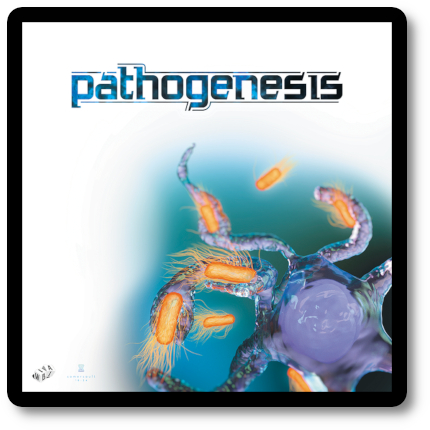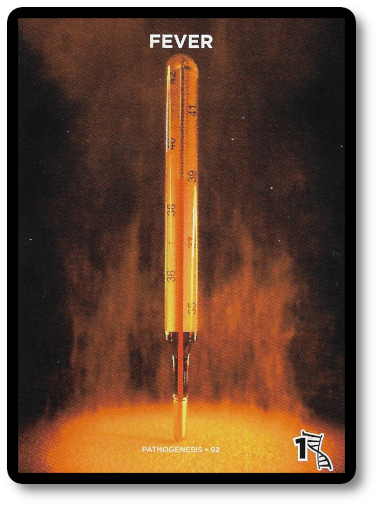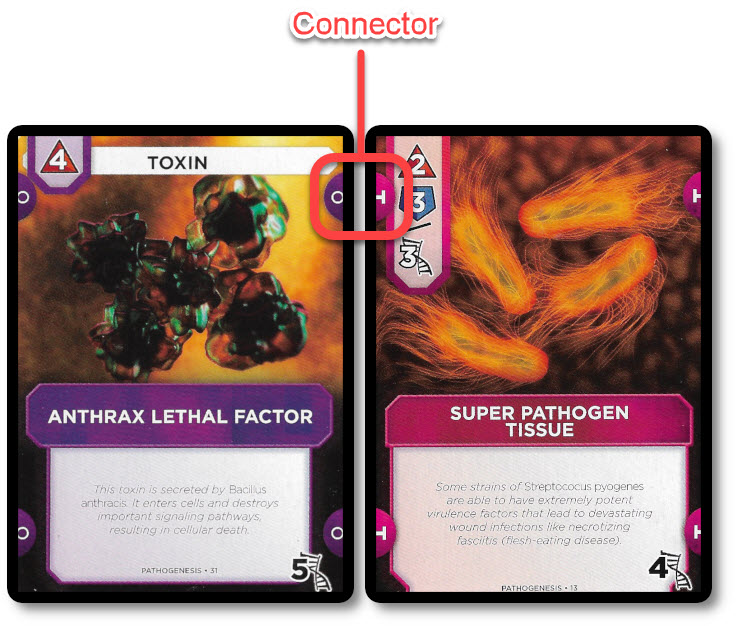Please Take Note: This is a review of the final game, but it might change slightly based on the success of the Kickstarter campaign. The game is being reviewed on the components and the rules provided with the understanding that “what you see is not what you might get” when the game is published. If you like what you read and want to learn more, we encourage you to visit the game’s website or Kickstarter campaign. Now that we have all that disclaimer junk out of the way, on with the review.

The Basics:
- For ages 10 and up (publisher suggests 14+)
- For 1 to 4 players
- Approximately 60 minutes to complete
Geek Skills:
- Active Listening & Communication
- Counting & Math
- Logical & Critical Decision Making
- Reading
- Strategy & Tactics
- Cooperative & Team Play
- Hand/Resource Management
Learning Curve:
- Child – Moderate
- Adult – Easy
Theme & Narrative:
- Body wars
Endorsements
- Gamer Geek mixed!
- Parent Geek approved!
- Child Geek approved!
Overview
American science, nature and travel writer, David Quammen, said “You can’t take a knife on a plane anymore, but you can get on carrying a virus.” Suggesting that a virus is just as dangerous as a weapon, which is correct. The Center for Disease control calculated that 48.8 million people suffered the flu in 2018. Out of that number, 79,400 lost their lives to it. Death by a virus. Something so small you need a powerful microscope to see it. In this game, you will play as the virus attacking the body. It’s an epic battle at a very micro-level.
Pathogenesis, designed by Jamie Cunningham and Loren Cunningham will be published by WIBAI Games. This is the second edition of the game first published in 2017. New and improved! The cards are as thick and as durable as your standard playing card. The boards and tokens are also thick and durable. The Petri dishes are real little Petri dishes, although they are made of plastic instead of glass.
It Starts with a Cough
To set up the game, first determine the game mode to be played. There are four types of game modes (solo, cooperative, competitive, and team play) with six different levels of difficulty and length of game play. A table is provided on the back of the game rules to help determine the number of game components to be used during game set up.
Second, place the Body Tract board in the middle of the playing area.
Third, shuffle the Barrier cards for each tract and place face-down on their designated spot. Flip the top card of each deck face-up to create the Active Gene Pool.
Fourth, place a Petri dish on their designated area and add the correct number of Damage counters.
Fifth, take Immune Response cards, remove the number needed based on the game mode to be played. Shuffle and place face-down.
Sixth, shuffle the Gene Pool deck and place face-down. Draw the top five cards and place face-up to form a row.
Seventh, place the seven Pathogen Supply decks and the Fever Supply deck.
Eighth, have each player select a starting deck and choose six of the New DNA cards. Players shuffle the selected cards along with four pathogens to create their initial deck. Players draw five cards from their deck to create their starting hand.
Ninth, place the tokens off to one side to create the token supply pools.
Tenth, determine which player will go first. The next player in turn order sequence receives one generic token, the third player receives two, and the fourth player receives three.
That’s it for game set up. Time to attack the body!
Then the Fever Hits
Pathogenesis is played in rounds and turns with no set number of rounds per game. A players’ turn is summarized here. Note that Pathogenesis is a deck-building game. This means the cards each player has will always be different. While the overall actions during the game remain similar to all players, availability of said actions and their possible outcomes are unique to the player’s played cards.
Phase One: Buy and Play
During this phase, the player can use card abilities to draw additional cards, remove cards, and affect other players. Some of the player’s cards will have a value that allow the player to buy new cards from the Active Gene Pool and the face-up Pathogen or Fever Supply cards. Newly acquired cards are place in the player’s personal discard pile.

Keep in mind you are a virus, so a fever is a good thing
There are four types of cards that can be played from the player’s hand. These are pathogens, traits, toxins, and environment cards. It costs nothing to play a card from the player’s hand, but players cannot play a card for its ability and use it for its value to purchase new cards. In addition, some cards, once played, are “locked”, meaning they cannot be swapped out, rearranged, or removed.
Cards played can “chain”, attaching themselves to create stronger viruses and attacks through mutation connections. However, a virus can only ever attack one specific tract of the body in most cases.

Phase Two: Preemptive Attack
Some cards allow the player to attack the Body during this phase. If the cards do, the player activates the card and resolves if. If the player does not, the phase is skipped without penalty.
Phase Three: Immune Response Attack
The player now draws one Immune Response card and resolve it if possible. The Body, you see, fights back. As the game progresses, the Body attempts to fight off what’s attacking it. In game terms, this means random events occur that impact what the players have done so far and what they can do in the future. For example, the below card adds an IgG token into the game which will make certain immune attacks stronger.

Phase Four: Pathogens Attack the Body
Any surviving pathogens still in play now attack the Body. Damage is calculated and the appropriate number of Damage tokens are removed from the targeted Petri dishes.
Phase Five: Clean Up
Played and destroyed cards during the player’s turn are now discarded. Cards not played can be kept or discarded, as well. The player then draws five new cards from their personal draw deck. If the player’s personal draw deck is depleted, they take their discard pile, shuffle, and place it face-down to create their new draw deck. The next player in turn order sequence now goes.
Broken Biological Clock
At the end of the third and consecutive rounds, one Immune Response card is removed if certain conditions are met. During the game, if a player needs to draw an Immune Response card and cannot, the game comes to an end. The Body has become immune to the players’ attacks resulting in all the players losing the game. However, if at anytime the correct number of body tracts are depleted (depending on the difficulty of the game the player’s selected), the Body fails and the players’ win if playing cooperatively. Otherwise, the player or team who collected the most Damage tokens during the game (signifying they did the most damage to the Body) wins.
To learn more about Pathogenesis, visit the game’s website or Kickstarter campaign.
Final Word
 The Child Geeks had difficulty pronouncing the cards in the game, but not once were they confused about how to go about playing the game. According to one Child Geek, “I cannot pronounce some of these cards and I don’t know what most of them are supposed to be, but I always knew how I wanted to go about attacking the body.” The Child Geek makes an excellent point here. The game uses real science terminology that I would argue most children and adults know nothing about. This proved to not be an issue as the card descriptions and game terms are easy to grasp. Another Child Geek said, “It felt weird being the bad guy, but I had a lot of fun.” Now this I really like. All of the Child Geeks understood that they were playing as the invaders and what they were attacking was a living body. Interestingly enough, they all saw the Body as a human, but this is not the case. It’s just the organic target. But in the eyes of the Child Geeks, they were attacking a person which made them the bad guys. Which, I must add, did nothing to stop them from having fun. All the Child Geeks voted to approve Pathogenesis.
The Child Geeks had difficulty pronouncing the cards in the game, but not once were they confused about how to go about playing the game. According to one Child Geek, “I cannot pronounce some of these cards and I don’t know what most of them are supposed to be, but I always knew how I wanted to go about attacking the body.” The Child Geek makes an excellent point here. The game uses real science terminology that I would argue most children and adults know nothing about. This proved to not be an issue as the card descriptions and game terms are easy to grasp. Another Child Geek said, “It felt weird being the bad guy, but I had a lot of fun.” Now this I really like. All of the Child Geeks understood that they were playing as the invaders and what they were attacking was a living body. Interestingly enough, they all saw the Body as a human, but this is not the case. It’s just the organic target. But in the eyes of the Child Geeks, they were attacking a person which made them the bad guys. Which, I must add, did nothing to stop them from having fun. All the Child Geeks voted to approve Pathogenesis.
 The Parent Geeks liked what the game was about and how it went about it. According to one Parent Geek, “Finally! A game that is not only fun to play but also helps me further my campaign of washing hands and covering your mouth when you sneeze!” Here in Minnesota, we are deep in cold and flu season. This game came at a good time when all our Parent Geeks were waging an epic battle of their own at home in an attempt to keep their family healthy. As one Parent Geek put it, “This was an entertaining game with both my friends and my family. Extra bonus points for also being a game I could use to remind my kids the reasons why we stay healthy and the consequences of not taking care of yourself.” All the Parent Geeks voted to approve Pathogenesis, finding it to be a game that was both entertaining and educational.
The Parent Geeks liked what the game was about and how it went about it. According to one Parent Geek, “Finally! A game that is not only fun to play but also helps me further my campaign of washing hands and covering your mouth when you sneeze!” Here in Minnesota, we are deep in cold and flu season. This game came at a good time when all our Parent Geeks were waging an epic battle of their own at home in an attempt to keep their family healthy. As one Parent Geek put it, “This was an entertaining game with both my friends and my family. Extra bonus points for also being a game I could use to remind my kids the reasons why we stay healthy and the consequences of not taking care of yourself.” All the Parent Geeks voted to approve Pathogenesis, finding it to be a game that was both entertaining and educational.
 The Gamer Geeks were disappointed. According to one Gamer Geek, “I understand the designer’s intent – which I believe was to create a game that was both educational and entertaining – but I think they only hit the educational target. I found the game to be too easy and repetitive in its approach to obtaining victory. None of my attacks felt anything more than just a card flop with a resolution.” Another Gamer Geek said, “A solid game, mechanically speaking, but I never found myself really getting into it. That said, I think this is a good game. I’m just not interested in the game’s overall theme.” All the Gamer Geeks agreed that the game itself was well designed. What they could not agree on was if the game was entertaining. Half of the gaming elitist suggested that it was, liking the new approach, while the other half believed the game brought nothing new to the table or was particularly interesting. This resulted in the game getting a mixed endorsement from our Gamer Geeks.
The Gamer Geeks were disappointed. According to one Gamer Geek, “I understand the designer’s intent – which I believe was to create a game that was both educational and entertaining – but I think they only hit the educational target. I found the game to be too easy and repetitive in its approach to obtaining victory. None of my attacks felt anything more than just a card flop with a resolution.” Another Gamer Geek said, “A solid game, mechanically speaking, but I never found myself really getting into it. That said, I think this is a good game. I’m just not interested in the game’s overall theme.” All the Gamer Geeks agreed that the game itself was well designed. What they could not agree on was if the game was entertaining. Half of the gaming elitist suggested that it was, liking the new approach, while the other half believed the game brought nothing new to the table or was particularly interesting. This resulted in the game getting a mixed endorsement from our Gamer Geeks.
 Pathogenesis is both a game and an interactive health lesson. Game wise, it’s a good time. The rules are very straight forward and the game visually organizes and adapts to the player’s actions. There is always enough information at the table to help players understand what is available to them, but it stops well short of explaining or hinting to the player how to go about their actions. While the player is working out their turn, they cannot help but learn a thing or two about the human body in the process.
Pathogenesis is both a game and an interactive health lesson. Game wise, it’s a good time. The rules are very straight forward and the game visually organizes and adapts to the player’s actions. There is always enough information at the table to help players understand what is available to them, but it stops well short of explaining or hinting to the player how to go about their actions. While the player is working out their turn, they cannot help but learn a thing or two about the human body in the process.
In an interesting twist, the players are the bad guys in this game. From our perspective, we look at most bacteria and viruses as invaders that threaten our health. In this game, the tables are turned and the players are attacking the very body we maintain through a healthy diet and exercise. A neat new take that doesn’t come across as too heavy in its message or complicated in its delivery. Even our youngest Child Geeks who played were able to easily make the connection between what was happening in the game and what that meant in real life. In short, the body gets sick. Attack it enough and the body dies. Easy stuff and a lesson that is loudly shouted in the player’s ears. “Keep the body healthy or else”.
The game is based on real medical science, but don’t let that scare you away. One need not be a medical student or doctor to play this game. The most complicated aspect of the “real science” in the game is the name of the cards. As mentioned by our Child Geeks, a number of the cards are difficult to pronounce. However, they are not difficult to use. How each card can be used is clear enough to empower the player to make choices. It doesn’t matter if the player can pronounce the card or even understands the health science behind it.
Like most deck-building games, players look for ways to optimize their decks so each of their turns are as productive as possible. While a player can always attack the Body, where a truly strategic player focuses is on attacking a single tract of the Body. This sounds easy in its approach, but it proved to be a challenge when attempting to build a deck that targeted a specific tract with mutations, but was still resilient and flexible enough to adjust to the ongoing game play changes. This made the deck-building aspect entertaining and meaningful, as the game’s response to the different attacks and how it reacted to it made each round and turn feel – if you’ll pardon the pun – organic.
I very much enjoyed Pathogenesis. I have played many, many deck-building games and didn’t find this game to be breaking new ground, but I very much enjoyed its different thematic approach. Plus I learned something in the process. Not too shabby. Do give this game a try when time allows.
This is a paid for review of the game’s final prototype. Although our time and focus was financially compensated, our words are our own. We’d need at least 10 million dollars before we started saying what other people wanted. Such is the statuesque and legendary integrity of Father Geek which cannot be bought except by those who own their own private islands and small countries.



